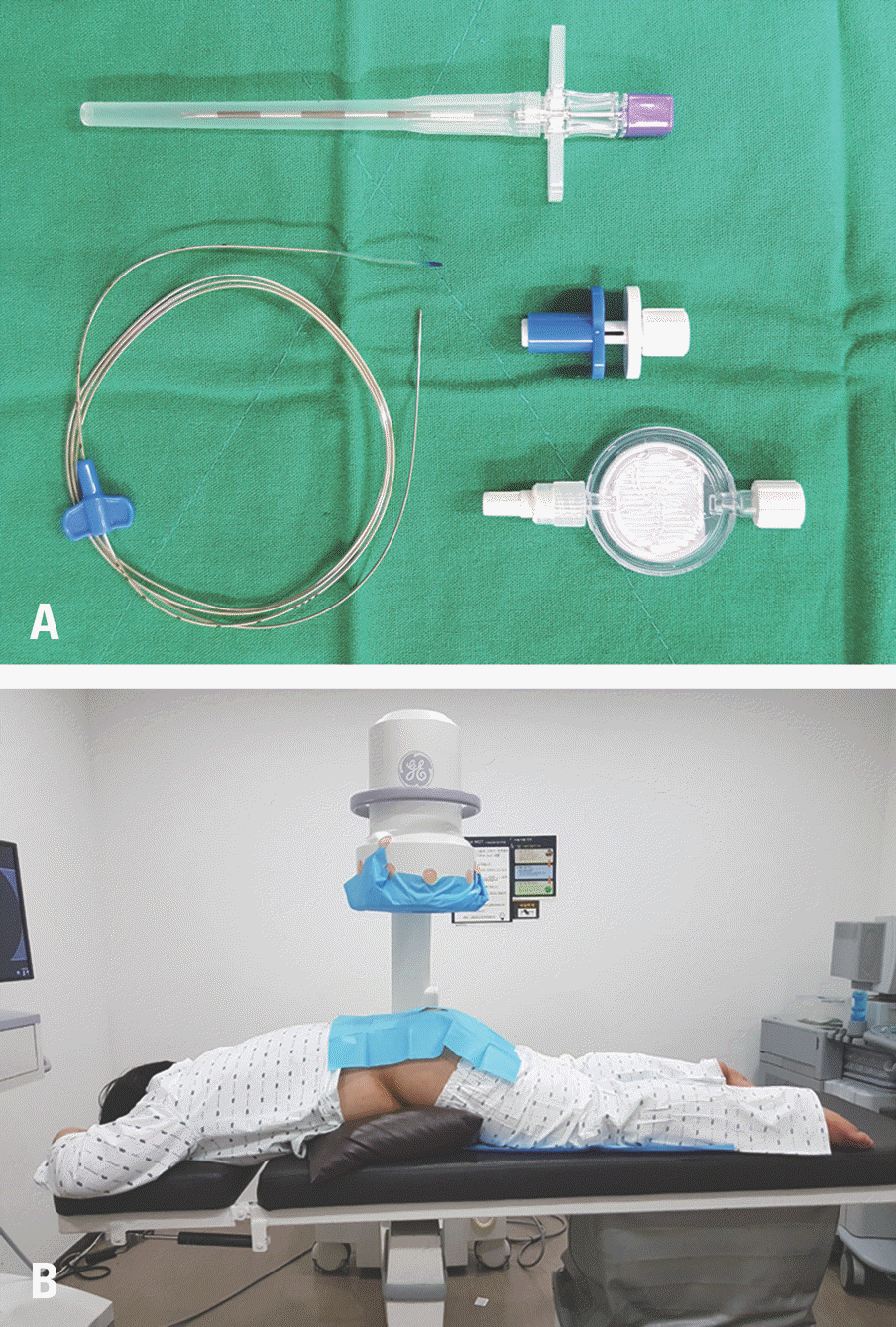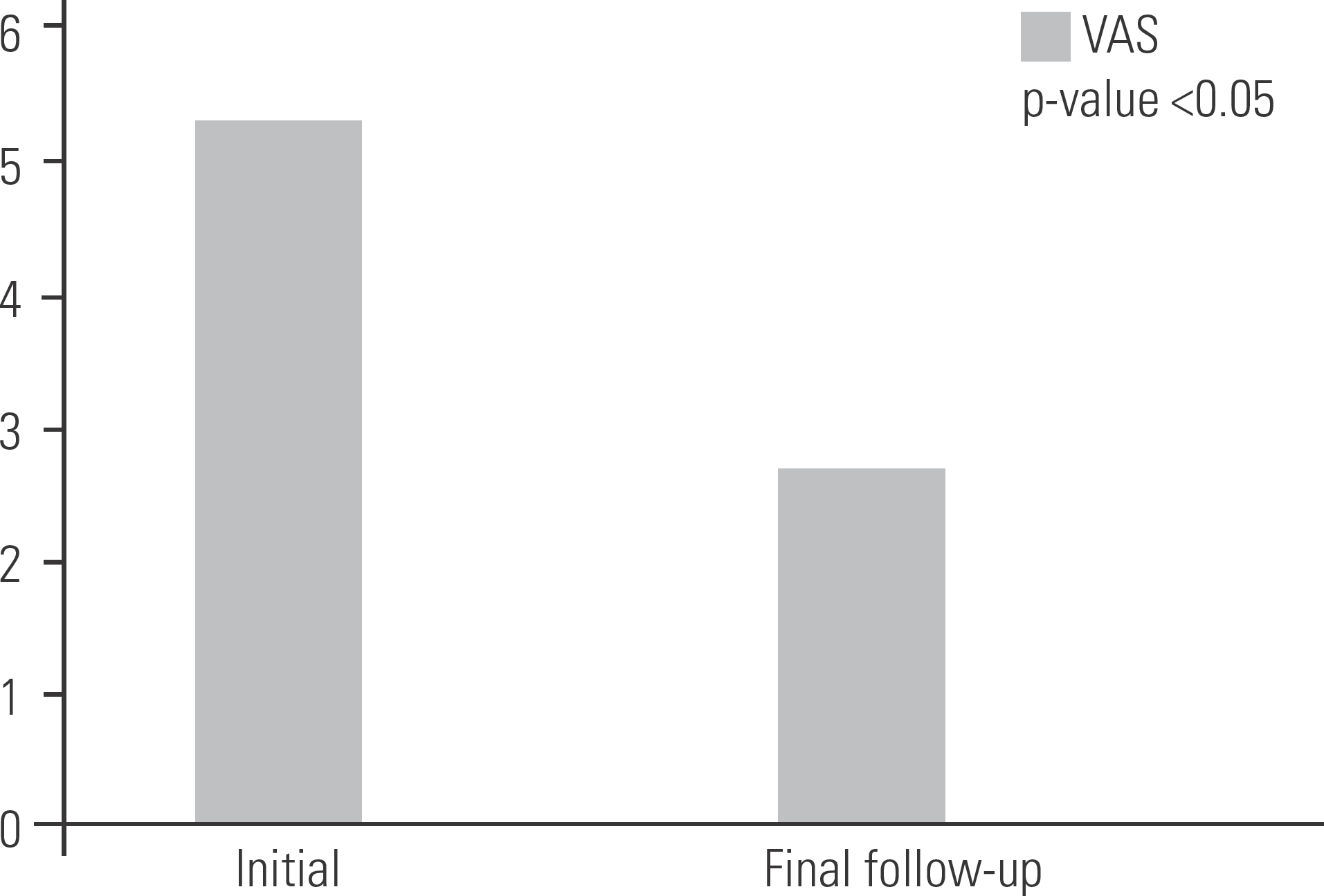Abstract
Objectives
The purpose of this study was to analyze and report the results of caudal epidural injections using a catheter in patients in whom conventional epidural block had failed.
Summary of Literature Review
Epidural nerve block is often used to treat chronic back pain and radicular pain in degenerative lumbar disease, and percutaneous epidural neuroplasty or surgery may be an alternative if it fails.
Material and Methods
In total, 146 patients who were treated with caudal epidural block using a catheter were recruited for this study from January 1, 2015 to June 30, 2019. Forty-five patients who had not undergone any epidural block in the past were excluded from the study. Among patients who did not have a fracture and were followed up for at least 1 month, the medical records of 61 patients with degenerative disc herniation, spondylosis, and stenosis were reviewed retrospectively. Visual analogue scale (VAS) scores were evaluated before and after the procedure.
Results
Of the 61 patients who had undergone epidural block through a transforaminal caudal approach with no pain control effect, there were 18 males and 43 females. Their mean age was 66.3 years and the average follow-up period was 2.64 months. There were 46 cases of spinal stenosis, 33 cases of spondylosis, 2 cases of spondylolisthesis, 9 cases of disc herniation and 1 case of ankylosing spondylitis. The mean number of epidural blocks was 5.85 (times) before the procedure. The mean initial VAS score was 5.34 and the final follow-up VAS score was 2.70. There was a significant difference between before and after the procedure (p<0.05). The mean duration of effect after the procedure was 1.84 months and the mean number of procedures was 2.30. After the procedure, there were 4 cases of surgical treatment, 2 cases of neuroplasty, and 3 cases of epidural block using other methods over more than 1 year of follow-up.
REFERENCES
1. Manchikanti L, Helm Ii S, Pampati V, et al. Percutaneous adhesiolysis procedures in the medicare population: analysis of utilization and growth patterns from 2000 to 2011. Pain Physician. 2014 Mar-Apr; 17(2):E129–39.
2. Chan CW, Peng P. Failed back surgery syndrome. Pain Med. 2011 Apr; 12(4):577–606. DOI: 10.1111/j.1526-4637.2011.01089.x.

3. Daffner SD, Hymanson HJ, Wang JC. Cost and use of conservative management of lumbar disc herniation before surgical discectomy. Spine J. 2010 Jun; 10(6):463–8. DOI: 10.1016/j.spinee.2010.02.005.

4. Rabinovitch DL, Peliowski A, Furlan AD. Influence of lumbar epidural injection volume on pain relief for radicular leg pain and/or low back spine. Spine J. 2009 Jun; 9(6):509–17. DOI: 10.1016/j.spinee.2009.03.003.
5. Lindahl O, Rexed B. Histologic changes in spinal nerve roots of operated cases of sciatica. Acta Orthop Scand. 1951; 20(3):215–25. DOI: 10.3109/17453675108991169.

6. Macnab I. Negative disc exploration. An analysis of the causes of nerve-root involvement in sixty-eight patients. J Bone Joint Surg Am. 1971 Jul; 53(5):891–903.
7. Roberts ST, Willick SE, Rho ME, et al. Efficacy of lumbosa-cral transforaminal epidural steroid injections: a systematic review. PM R. 2009 Jul; 1(7):657–68. DOI: 10.1016/j.pmrj.2009.04.008.

8. Carette S, Leclaire R, Marcoux S, et al. Epidural corticosteroid injections for sciatica due to herniated nucleus pulposus. N Engl J Med. 1997 Jun; 336(23):1634–40. DOI: 10.1056/NEJM199706053362303.

9. Jinkins JR, Whittemore AR, Bradley WG. The ana-tomic basis of vertebrogenic pain and the autonomic syndrome associated with lumbar disk extrusion. AJR Am J Roentgenol. 1989 Jun; 152(6):1277–89. DOI: 10.2214/ajr.152.6.1277.

10. Lee HM, Weinstein JN, Meller ST, et al. The role of ste-roids and their effects on phospholipase A2. An animal model of radiculopathy. Spine (Phila Pa 1976). 1998 Jun; 23(11):1191–6.
11. Takahashi N, Yabuki S, Aoki Y, et al. Pathomechanisms of nerve root injury caused by disc herniation: an experimental study of mechanical compression and chemical irritation. Spine (Phila Pa 1976). 2003 Mar 1; 28(5):435–41. DOI: 10.1097/01.BRS.0000048645.33118.02.
12. Kang JD, Georgescu HI, McIntyre-Larkin L, et al. Herniated lumbar intervertebral discs spontaneously produce matrix metalloproteinases, nitric oxide, interleukin-6, and prostaglandin E2. Spine (Phila Pa 1976). 1996 Feb; 21(3):271–7.

13. Yabuki S, Igarashi T, Kikuchi S. Application of nucleus pulpo-sus to the nerve root simultaneously reduces blood flow in dorsal root ganglion and corresponding hindpaw in the rat. Spine. (Phila Pa 1976). 2000 Jun; 25(12):1471–6.
14. Johansson A, Hao J, Sjolund B. Local corticosteroid application blocks transmission in normal nociceptive C-fibres. Acta Anaesthesiol Scand. 1990 Jul; 34(5):335–8. DOI: 10.1111/j.1399-6576.1990.tb03097.x.

15. Racz GB, Holubec JT. Lysis of adhesions in the epidural space. Techniques of Neurolysis. Boston(MA): Kluwer;1989. 57-72. DOI: 10.1007/978-1-4899-6721-3_6.
16. Racz GB, et al. Percutaneous Lysis of Epidural Adhesions— Evidence for Safety and Efficacy. Pain Pract. 2008 Jul-Aug.
Fig. 1.
(A) Caudal catheter (EPINA PLUS, Ace Medical. Seoul, Korea). (B) The patient's position during a caudal epidural injection with a catheter.

Fig. 2.
Case of epidural block using a caudal catheter. The patient had received transforaminal epidural block twice. (A, B) Sagittal and axial views on magnetic resonance imaging, showing degenerative spondylosis, central stenosis, and foraminal stenosis. (C) Post C-arm image. The contrast medium diffused well after the caudal epidural injection using a caudal catheter.

Table 1.
Baseline data of patients




 PDF
PDF Citation
Citation Print
Print



 XML Download
XML Download